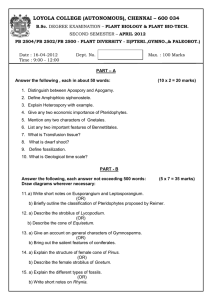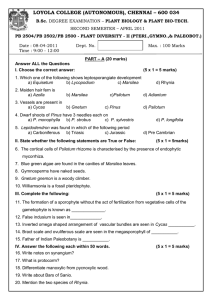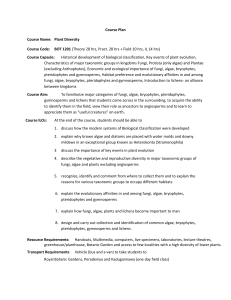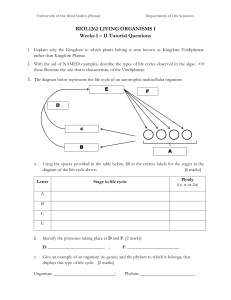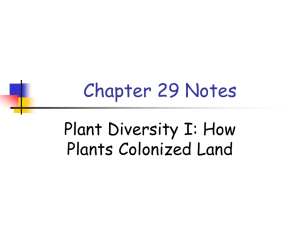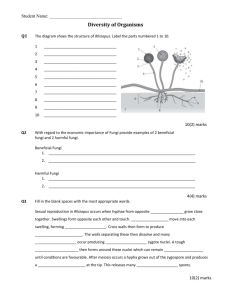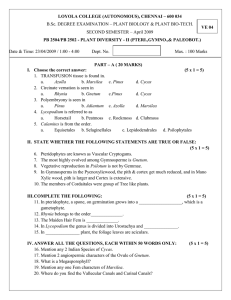LOYOLA COLLEGE (AUTONOMOUS), CHENNAI 600 034 B.SC. DEGREE EXAMINATION PLANT BIOLOGY AND BITECHNOLOGY
advertisement
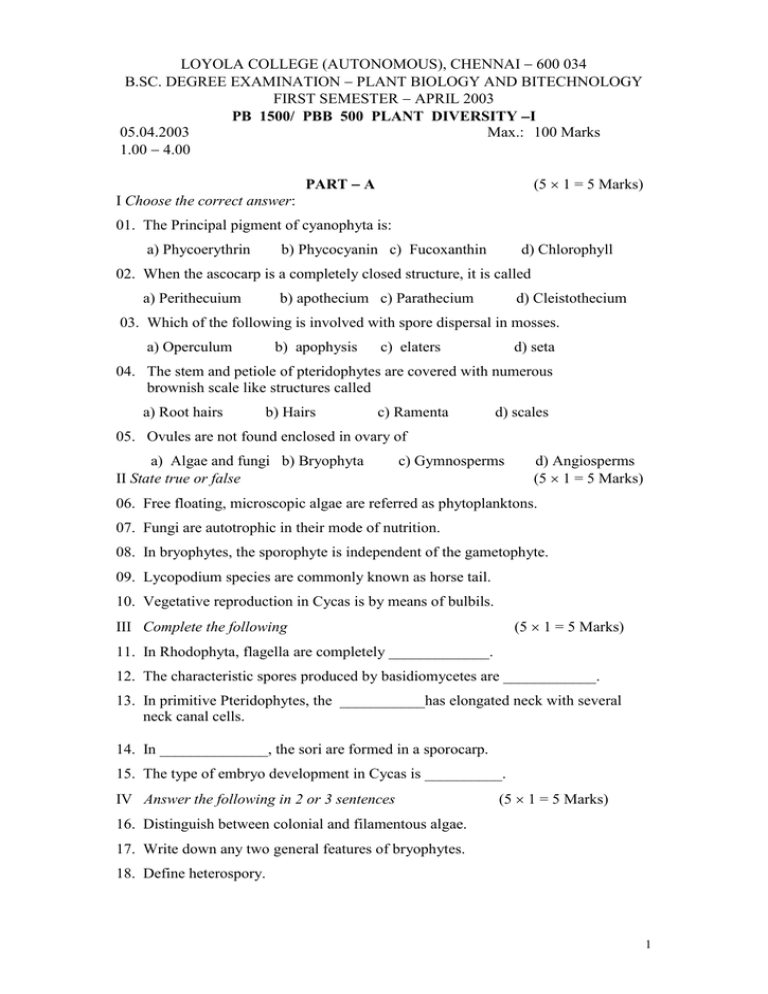
LOYOLA COLLEGE (AUTONOMOUS), CHENNAI 600 034 B.SC. DEGREE EXAMINATION PLANT BIOLOGY AND BITECHNOLOGY FIRST SEMESTER APRIL 2003 PB 1500/ PBB 500 PLANT DIVERSITY I 05.04.2003 Max.: 100 Marks 1.00 4.00 PART A (5 1 = 5 Marks) I Choose the correct answer: 01. The Principal pigment of cyanophyta is: a) Phycoerythrin b) Phycocyanin c) Fucoxanthin d) Chlorophyll 02. When the ascocarp is a completely closed structure, it is called a) Perithecuium b) apothecium c) Parathecium d) Cleistothecium 03. Which of the following is involved with spore dispersal in mosses. a) Operculum b) apophysis c) elaters d) seta 04. The stem and petiole of pteridophytes are covered with numerous brownish scale like structures called a) Root hairs b) Hairs c) Ramenta d) scales 05. Ovules are not found enclosed in ovary of a) Algae and fungi b) Bryophyta II State true or false c) Gymnosperms d) Angiosperms (5 1 = 5 Marks) 06. Free floating, microscopic algae are referred as phytoplanktons. 07. Fungi are autotrophic in their mode of nutrition. 08. In bryophytes, the sporophyte is independent of the gametophyte. 09. Lycopodium species are commonly known as horse tail. 10. Vegetative reproduction in Cycas is by means of bulbils. (5 1 = 5 Marks) III Complete the following 11. In Rhodophyta, flagella are completely _____________. 12. The characteristic spores produced by basidiomycetes are ____________. 13. In primitive Pteridophytes, the ___________has elongated neck with several neck canal cells. 14. In ______________, the sori are formed in a sporocarp. 15. The type of embryo development in Cycas is __________. IV Answer the following in 2 or 3 sentences (5 1 = 5 Marks) 16. Distinguish between colonial and filamentous algae. 17. Write down any two general features of bryophytes. 18. Define heterospory. 1 19. Write about the structure of protocorm. 20. Write notes on ovuliferous scale of Pinus. PART B (5 8 = 40 Marks) Answer any FIVE questions, choosing not more than three from each section. Each within 350 words. SECTION I 21. Bringout the salient features of phaeophyta and chlorophyta in the form of tabular column 22. Explain any two types of life cycle patterns seen in fungi. 23. Explain the structure of mature sporophyte of Anthoceros . 24. Draw diagrams only: a) Cyanophycean cell b) Basidocarp of Polyporus c) Moss plant body. SECTION II 25. List the characteristics of Filicophyta. 26. Distinguish between Eusporangium and Leptosporangium. 27. Draw a well labelled diagram of Cycas ovule and discuss its structure. 28. Describe the internal structure of Pinus needle. PART C (2 20 = 40 Marks) Answer the following, Each with in 1500 words. Draw necessary diagrams. Necessary diagrams. 29. a) Explain the following. i) Habitats of algae ii) ascocarps in fungi iii) sex organs of bryophytes. b) Write short notes on i) pigments and cell wall composition in any five algal divisions ii) asexual spores in fungi iii) adaptations in bryophytes 30. a) Explain the following i) types of protosteles in pteridophytes ii) Sexual reproduction in pteridophytes iii) Altered and unaltered fossils (OR) b) Write notes on i) External features of Gnetum ii) Reproductive features of Gymnosperms iii) Economic importance of Gymnosperms. ***** 2
